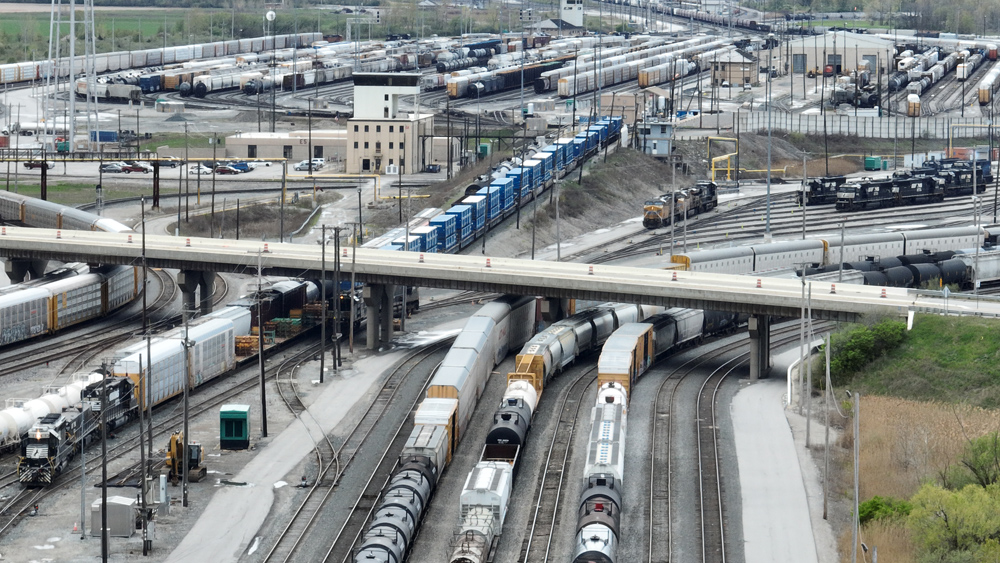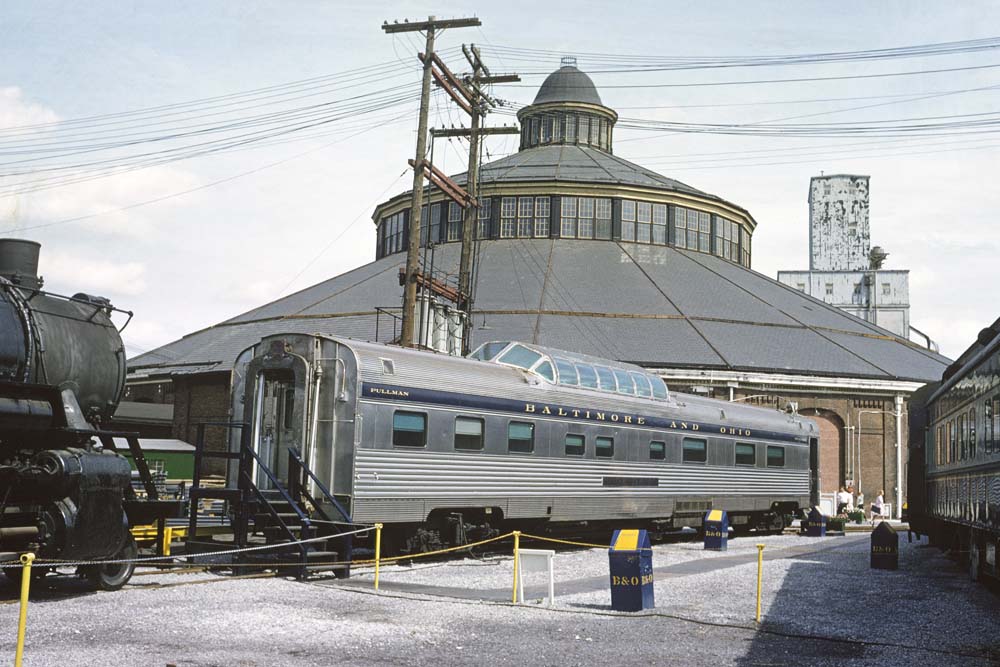Bellevue Yard

It’s over 5 miles long.
It’s capable of serving a hundred trains a day.
It’s the center point of five of Norfolk Southern’s busiest lines.
Officially known as Moorman Yard, Norfolk Southern’s Bellevue hump yard is one of the largest in the railroad’s system. Centrally located in the northern Ohio heartland, it’s a linchpin in the NS carload freight network, without which the entire railroad would grind to a halt.
Nickel Plated beginnings
Built by the Nickel Plate Road in the early 1880s, Bellevue Yard served as the junction between the railway’s Cleveland and Fort Wayne divisions on its Buffalo-Chicago main line. The city was also served by the Pennsylvania, New York Central, and Wheeling & Lake Erie railroads, and the yard soon became an integral transfer point for goods moving throughout the NKP system. This was reinforced when the W&LE came under NKP control in 1947, adding direct NKP service to Toledo and Akron. While sizable for the time, Bellevue had not yet become the massive sorting facility it is now. The yard’s claim to fame was serving as the home for many of the NKP’s powerful 700-series Berkshires, for which the railroad built a new roundhouse in the late 1940s.
Super size
In the 1950s, the booming U.S. economy lifted nearly every industry, and the Nickel Plate was no exception. The company’s lease of the W&LE meant a steady stream of coal-train revenue was flowing in, and the introduction of the diesel locomotive brought a decrease in motive power operating costs, even if it meant the demise of the fan-favorite Berkshires.
However, all was not well elsewhere, as other railroads began to merge. For the Nickel Plate, a proposed merger of the New York Central and Pennsylvania railroads seemed like an existential threat. A “Pennsylvania Central” system would have two main lines directly paralleling the NKP, which would eat into the company’s business tremendously. Additionally, competition from the new federal highway system was siphoning off both passengers and freight. As the 1960s began, the Nickel Plate began to search for its own merger partner. While union with east-end connection Lackawanna was first tried, the railroad eventually found a suitor in the coal fields to the south: the Norfolk & Western.
At the same time, work began on a large expansion of Bellevue Yard. With the company’s 1950s success, the facilities in Bellevue were now inadequate,and work began on a dramatic scale.
Originally the yard stretched over a mile from Buckeye Street in downtown Bellevue to Prairie Road on the eastern outskirts. The new hump yard, constructed in the early 1960s, extended an additional mile and a half to the northeast, terminating near Ohio Route 4, now on an overpass. Another 2 miles of yard tracks stretched off to the northeast, terminating near Ohio Route 99. This section gave yard crews more than enough room to both push trains over the hump and prepare outbounds. A new locomotive shop was built next to the hump, and a railcar maintenance facility was located on one side of the sorting bowl. Room was left to the south for a further expansion, the outermost expanse of which was marked by passing tracks. Completing these additions took so long that the beneficiary of the Nickel Plate’s hard work was the Norfolk & Western, which inherited the project near its completion.
The N&W had added the NKP and the Wabash during the early-60s merger mania, and to connect its new roads also bought the Pennsylvania Railroad’s Sandusky District, which ran through Bellevue. This reduced the number of railroads operating through Bellevue to just two, with the N&W controlling the former NKP, WLE, and PRR alignments, while the New York Central still ran trains over the Lake Shore & Michigan Southern route from Toledo to Cleveland via Norwalk. Shortly thereafter the proposed “Pennsylvania Central” merger became a reality in February 1968, and the NYC line became part of the Penn Central, before it was abandoned in the 1970s as PC fell apart at the seams. Bellevue became a one-railway town, although this was to change.
A dark horse rises
While the rail industry saw numerous changes during the 1970s, few made it to Bellevue. The yard just worked, as did the N&W. While Penn Central imploded, and many U.S. railroads hit their nadir, the Norfolk & Western kept on chugging, and cars kept going over the hump at Bellevue. The period’s most notable feature was the wide array of yard power; engines shoving cars over the hump could have the words “Nickel Plate,” “Virginian,” or “Wabash” poking through thin spots of their N&W blue, and later black, paint.
The arrival of the 1980s brought Norfolk Southern, created from a merger of N&W and the Southern. Still, little changed in Bellevue. The N&W black gained a prancing horse on the front, and Southern black-and-cream diesels began trickling in. By far the most interesting new thing at Bellevue was the arrival of ex-Milwaukee Road F7 No. 82C, stored at the locomotive shop on behalf of a historical society for a few years. Additionally, the Wheeling & Lake Erie, divested from NS as part of the original merger, now operated trains into Bellevue as an independent short line. The new W&LE remains the only other carrier to serve Bellevue since the failure of Penn Central.
Then came Conrail, or rather, its dissolution in 1999. Norfolk Southern gained 58% of Conrail in the split with CSX, and with it came over 7,000 new route-miles of track. These included the former PRR main line through the mountains of Pennsylvania and New York Central’s Chicago line, running from Cleveland to its titular city. NS took ownership of Conrail’s assets on June 1, 1999, and traffic at the railroad’s yards spiked to new levels almost immediately.
Bellevue soon became a noted pain point in the railway’s network, as it now sat at the center of five NS lines, and offered easy access to any point in the NS network. Within a decade, Bellevue traffic numbers were booming, and NS management pulled out their blueprints and their checkbooks …
Double it
In Spring 2012, Bellevue underwent its most dramatic change since the 1967 expansion, as Norfolk Southern added a second bowl to the hump yard at the cost of $160 million. The existing 42 tracks were supported by 38 in the new south bowl, doubling the yard’s capacity. A second track was added to the hump itself, thus giving crews the ability to sort two trains at once — something that no other NS yard could do at the time. The yard was built to with an expected capacity of 3,000 cars a day, making it capable of easily handling increased surges in carload traffic. As NS Vice President of Transportation Terry Evans said in 2015: “I can’t tell you how important this is for us. It changes our game in the Midwest.”
The expanded yard opened in 2015, but the entire hump yard was idled in 2020. The reasons are multi-faceted, but in the simplest terms possible, the introduction of Precision Scheduled Railroading de-emphasized the use of large sorting facilities across the U.S. rail network. When the COVID-19 pandemic hit, and the U.S. economy fell off a cliff, carload freight numbers cratered. The Bellevue hump facilities were closed, with trains flat-switched instead. At the same time, the Bellevue’s locomotive shop was closed, with duties transferred to the Conway and Juniata shops in Pennsylvania.
Today and the future
For nearly two years, the humps at Bellevue sat idle. However, in summer 2022, Norfolk Southern reactivated the hump facilities — the north bowl first, followed a month later by the south. In 2023, the yard has seen a return to pre-pandemic traffic levels, with dozens of trains arriving and departing every day. The yard’s locomotive shop has remained dormant, although there has been increased activity around the shops — yard locomotives are being serviced on-site instead of being hauled off to Conway for inspections and overhauls, and as NS began to return SD70M-2 locomotives to service in the early spring, some have undergone depot-level maintenance and reactivation work inside the Bellevue shops. Whether this is a temporary move or a sign of a return to work remains to be seen.
Bellevue still holds an important place in the NS system. Earlier in 2023, CEO Alan Shaw held a company-wide webinar from the yard, and the facility played host to a temporary emergency training facility organized after the East Palestine derailment.
Despite some minor setbacks, it seems Bellevue will continue to be the beating heart of NS’ Midwest operations for years to come.














I recall reading about the move to turn Bellevue into a flat switching yard and thinking it was a mistake. Glad NS didn’t bulldoze the hump like CSX did with some of their hump yards.